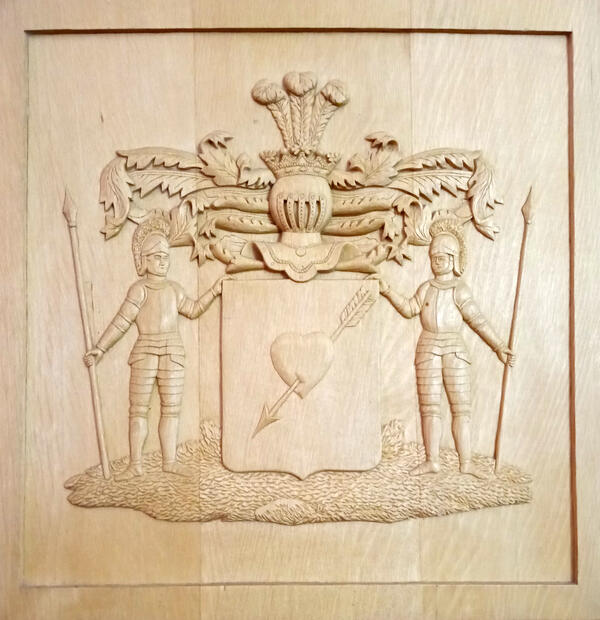It is believed that the Aksakov family dates back to the arrival of the famous Varangian warrior Shimon Afrikanovich to Kiev in the 10th century. The name of the Aksakovs (initially the Oksakovs) was included in the Velvet Book, a genealogical book that listed the most ancient and noble Boyar and noble families of Russia. For exceptional service in the 16th-17th centuries, the representatives of the Aksakov family were granted estates in the Novgorod region, Moscow, Tula, Simbirsk and many other counties. Despite the obvious nobility of the Aksakov family, they didn’t create their emblem until the end of the 18th century simultaneously to the state General Armorial of the Noble Families of the Russian Empire.
An exact copy of the Aksakovs’ coat of arms is carved on this wooden tablet. Its compositional center is the image of a shield topped with a helmet. On the right and left of the shield are soldiers armed with spears. The abundance of knightly paraphernalia symbolizes the military valor of the clan representatives, and the heart pierced by an arrow, which is depicted on the shield, speaks to their honor and justice. This coat of arms does not have Russian symbols and is very similar to European emblems, as it is a variation of the Aksak III Polish coat of arms.
In those days, almost complete copies of European coats of arms were not unusual. In Russia, the widespread use of coats of arms began at the turn of the 18th century. It was then that personal and family coats of arms profusely penetrated into the Russian Empire along with their owners from Western Europe, Lithuania, Poland, where heraldic traditions were well developed. Their European origin also determined the basic symbolism of the coats of arms for Russian nobility: they usually consisted of a shield, helmet, crown, crest, mantle, sometimes a few words and ornaments. Eight colors could be used in a coat of arms: gold, silver, red, blue, green, purple, black, white.
Overall, every Russian coat of arms can be divided into three large groups according to the origin of their owners. The first group includes those of all princely and noble families, which descend from Rurik and the Grand Duke of Lithuania Gediminas. The second group includes the coats of arms of all foreign surnames that have taken Russian citizenship, as such families were said to be moving on. Finally, the third group includes the coats of arms of persons who received nobility by honored ranks. Accordingly, the Aksakov family belongs to the latter.
An exact copy of the Aksakovs’ coat of arms is carved on this wooden tablet. Its compositional center is the image of a shield topped with a helmet. On the right and left of the shield are soldiers armed with spears. The abundance of knightly paraphernalia symbolizes the military valor of the clan representatives, and the heart pierced by an arrow, which is depicted on the shield, speaks to their honor and justice. This coat of arms does not have Russian symbols and is very similar to European emblems, as it is a variation of the Aksak III Polish coat of arms.
In those days, almost complete copies of European coats of arms were not unusual. In Russia, the widespread use of coats of arms began at the turn of the 18th century. It was then that personal and family coats of arms profusely penetrated into the Russian Empire along with their owners from Western Europe, Lithuania, Poland, where heraldic traditions were well developed. Their European origin also determined the basic symbolism of the coats of arms for Russian nobility: they usually consisted of a shield, helmet, crown, crest, mantle, sometimes a few words and ornaments. Eight colors could be used in a coat of arms: gold, silver, red, blue, green, purple, black, white.
Overall, every Russian coat of arms can be divided into three large groups according to the origin of their owners. The first group includes those of all princely and noble families, which descend from Rurik and the Grand Duke of Lithuania Gediminas. The second group includes the coats of arms of all foreign surnames that have taken Russian citizenship, as such families were said to be moving on. Finally, the third group includes the coats of arms of persons who received nobility by honored ranks. Accordingly, the Aksakov family belongs to the latter.



